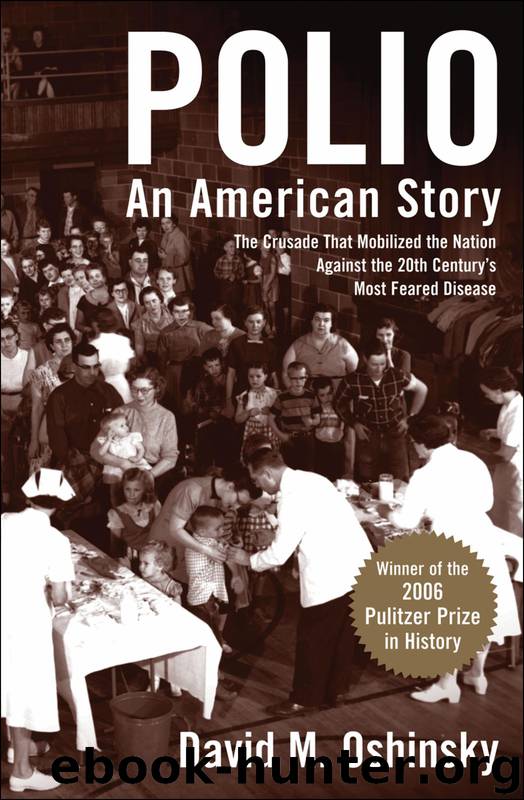Polio by Oshinsky David;

Author:Oshinsky, David;
Language: eng
Format: epub
Publisher: Oxford University Press
Published: 2005-08-19T16:00:00+00:00
LIKE JOSEPH BELL, THOMAS FRANCIS ENVISIONED a somewhat bigger field trial than the one the foundation had proposed. The objective was clear. Considering the incidence of paralytic polio among grade school children in the United States at this time—around 50 per 100,000—the sample, to be convincing, had to be very large. Suppose, said one statistician, that the vaccine was declared to be 50 percent effective. What would that mean? “With 40,000 in the [placebo] group and 40,000 in the vaccinated group, we would find about 20 control cases and 10 vaccinated cases, and a difference of this magnitude could be easily attributed to random variation. It would suggest that the vaccine might be effective, but it would not be persuasive. With 100,000 in each group, the expected number of polio cases would be 50 and 25, and such a result would be [more] persuasive.” Big numbers mattered.27
So, too, did the selection of volunteers. Hard choices would have to be made, leaving many parents bitterly disappointed. These trials, after all, were never intended to immunize the entire juvenile population. That wasn’t the point—nor was it possible. Commercial vaccine production had just begun. The plans for coding, transporting, and administering three doses of two identical-looking liquids were barely off the ground. Money was tight. As Hart Van Riper admitted, “we will have enough vaccine for between 500,000 and 1,000,000 children. It is, therefore, not feasible to go into every county in the U.S.”28
Studies showed that five-year-olds had the highest incidence of polio, making them prime candidates for vaccination. The problem, however, was that the foundation hoped to run its trials through the local school systems, where good record keeping and regular attendance made for “maximum ease and convenience.” This meant using slightly older subjects, starting logically with children in the first grade. But here, too, a difficulty arose. According to planners, the best model for a smooth-running polio trial showed second graders receiving the vaccination (real and placebo), with first and third graders acting as observed controls. In a memo, Van Riper explained why:
By selecting children in the second grade, comparable pre-vaccination records are available in the schools for this grade as well as the first and third grades.
By selecting the second grade, it is possible to compare the post-vaccination experience with the concurrent experience in the non-vaccinated children one grade before (first grade) and one grade later (third grade).
Second grade children are better adjusted psychologically to school life than are first grade children and therefore offer less resistance and unfavorable … reactions to a three-dose vaccination procedure.29
In the end, a compromise was reached. County officials who endorsed the model originally proposed by Salk and the National Foundation would inject only second grade volunteers with the real vaccine, while using first and third graders in the same schools as observed controls. Meanwhile, county officials who supported the model proposed by Bell and Francis would inoculate volunteers from all three grades—first, second, and third—with half receiving the real vaccine and half getting a placebo.
Download
This site does not store any files on its server. We only index and link to content provided by other sites. Please contact the content providers to delete copyright contents if any and email us, we'll remove relevant links or contents immediately.
| Administration & Medicine Economics | Allied Health Professions |
| Basic Sciences | Dentistry |
| History | Medical Informatics |
| Medicine | Nursing |
| Pharmacology | Psychology |
| Research | Veterinary Medicine |
Periodization Training for Sports by Tudor Bompa(7921)
Why We Sleep: Unlocking the Power of Sleep and Dreams by Matthew Walker(6357)
Paper Towns by Green John(4800)
The Immortal Life of Henrietta Lacks by Rebecca Skloot(4257)
The Sports Rules Book by Human Kinetics(4078)
Dynamic Alignment Through Imagery by Eric Franklin(3920)
ACSM's Complete Guide to Fitness & Health by ACSM(3824)
Kaplan MCAT Organic Chemistry Review: Created for MCAT 2015 (Kaplan Test Prep) by Kaplan(3801)
Introduction to Kinesiology by Shirl J. Hoffman(3626)
Livewired by David Eagleman(3534)
The River of Consciousness by Oliver Sacks(3418)
The Death of the Heart by Elizabeth Bowen(3340)
Alchemy and Alchemists by C. J. S. Thompson(3294)
Descartes' Error by Antonio Damasio(3166)
Bad Pharma by Ben Goldacre(3097)
The Emperor of All Maladies: A Biography of Cancer by Siddhartha Mukherjee(2930)
The Gene: An Intimate History by Siddhartha Mukherjee(2927)
The Fate of Rome: Climate, Disease, and the End of an Empire (The Princeton History of the Ancient World) by Kyle Harper(2873)
Kaplan MCAT Behavioral Sciences Review: Created for MCAT 2015 (Kaplan Test Prep) by Kaplan(2815)
